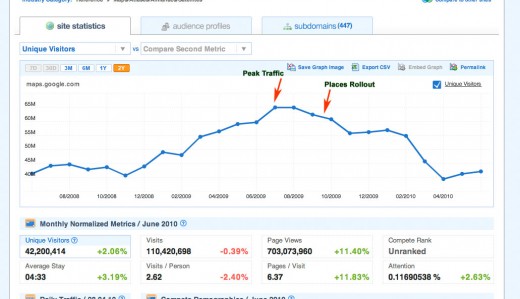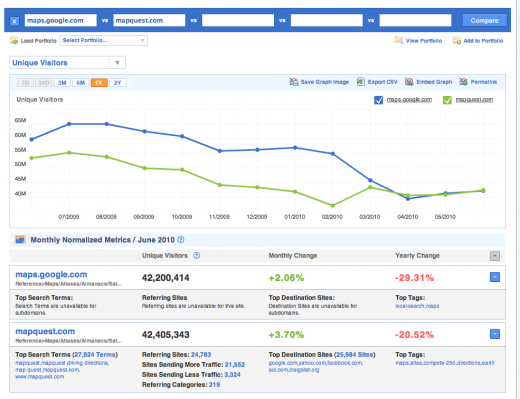Understanding Google My Business & Local Search
Whither Google Maps Traffic? Are Google Maps and Mapquest Once Again Vying for the Lead?
From the moment that Google Maps became Google Maps there has always been strong growth in the numbers of unique visitors. For period in from 2007-2009 it was growing at rates of 50 to 60% year over year. During that period it quickly passed Mapquest and Yahoo as the leading Mapping product. Often Google would increase traffic to Maps by changes to the main page of the results page.
According to Compete.com, things, at least for the .com desktop traffic, have changed dramatically. Google’s Maps has shown a mostly steady decline (despite a summer season uptick) for the last 11 months.
The reasons for a decline in desktop maps.google.com traffic is not totally clear. Certainly there has been a growth in the use of Maps via mobile Apps and we know that the Maps API provides a significant number of Map views across the greater web. But I doubt that either make up for the decline of 35% from the peak of 64,979 million visitors in Jul ’09 to 42,200 million visitors in June of this year. Current uniques visits have not been this low since July of 2008.
But the downturn in traffic has not just affected Google Maps. According to Heather Hopkins of Hitwise, in the broader category of desktop internet mapping products, visits to Mapping sites has declined across the board in relation to the rest of the internet.
Interestingly, it that appears that Google’s % of decline in unique visits is greater than that of Mapquest. This has resulted, at least on the desktop, in a virtual tie for the leading desktop Mapping product based on uniques. According to Hitwise total traffic to Google Maps exceeds Mapquest by 50% with Google holding a 51% to 31% edge in total traffic. This implies that even if uniques are close that engagement is much greater at Google.
Could increased mobile Map use be leading to a reduction desktop interaction? Perhaps there is less travel due to the poor economy or maybe user attention and visits are being diverted to the likes of Facebook? Have Universal Local results improved to the point that it is less necessary to penetrate the bowels of Maps?
I am curious why you think that mapping products have declined in general and why Maps has shown such a precipitous drop? Does it matter going forward or will mobile make up the slack?
© Copyright 2025 - MIKE BLUMENTHAL, ALL RIGHT RESERVED.


Comments
8 Comments
Your couple theories might account for most of the drop. We know people are using mapping programs on mobile devices – and at least personally, I often use the main Google search to find local businesses rather than going through maps. This would account for Google’s decline relative to Mapquest too.
On another note, I’m guesssing Compete doesn’t pick up visits to Google.com/maps – I have no idea why those would be growing as a % of total visits, but it could account for something.
My first thought is that Google Places pages may be stealing some of the thunder away from Google Maps. But the decline started before Google launched Places (in September of last year). Maybe that’s just one of a number of factors, like you mention (economy, less travel, etc.).
Google have been including maps in their organic search results for quite a while. A long time before they came up with the name “Google Places”.
So, Id still suspect this may be a major contributor to the down turn.
Interesting post Mike,
I think it’s a combination of a few things. First off, I believe mobile does play a big role in this decline. I think we are all still underestimating how much mobile is growing right now, and will continue to grow in the next few years. I pay close attention to how people around me are using mobile web, and it is really exciting. I am consistently shocked by the amount of click to calls we get every week from adwords, which is growing every week, and is just another example (to me) the growth of mobile. Not to mention I have heard on many occasions people saying they would rather search locally on their phone because they feel like they get better local results.
Second, I think that the increase in the amount of map-packs that Google is showing in their SERPS are having a huge factor in this decline. As I’m sure you have seen in the Places reports, there are huge differences between Impressions and Actions. I believe that people are becoming so accustomed to finding local business in Google SERPS, that they never need to search on Maps. They call a business without ever clicking through for more info, thus never carrying them over to the maps domain. I think we are seeing not only a huge tech change for local, but a behavioral one as well.
I was just sent comscore’s numbers and they tell a different story…so it could just be what compete is measuring….although given the definite trend that they are showing it does seem to imply something is going on somewhere..
Quantcast shows significant growth 41.2m to 52m in Jan – June period
I’m just wondering… could it be, that due to the picture these statistics are drawing, that Google has changed the UI of the OneBoxes (and maybe soon the Lucky-Seven Pack also), forcing the user to click through to maps.google.com via the new Link “Place Page”?
Anyway… I’m also following Micaheath comment, that one reason could also be the ever increasing mobile usage in local search…
Google maps on my iphone has delivered me to the wrong location – the past 5 times I’ve used it. They bring me pretty close to the correct spot but at least one block away. What is this – a game of Horseshoes? I would expect more of a steady decline unless they start throwing some ringers around here.
I’ve begun asking humans for directions. If there are no humans around I resort to my paper maps stuffed in the trunk. Paper maps are kinda cool.
Comments for this post are closed.